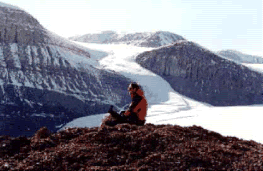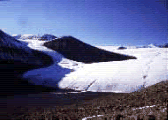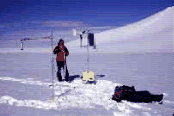

|
Drip, drip drip... is the glacier shrinking or expanding? |

Solar energy is a major factor during the 24- hour days in the high Arctic in determining glacial melt. |
It's one of the most remote places on earth, and some 4,000 years ago only a few people lived there. Norse artifacts have been unearthed dating from 1250-1350 AD. William Baffin actually saw the island in 1616. But Ellesmere Island wasn't actually explored until two centuries later.
Today a team of University of Alberta researchers calls Canada's most northerly island home on an intermittent basis. The research they're conducting may unlock some important clues about how the world's glaciers grow and shrink. And the work Earth and Atmospheric Sciences graduate student Anthony Arendt is doing may help climatologists piece together a few more parts of the global warming puzzle.

Anthony Arendt has established three data collection stations on John Evans Glacier. |
Arendt is paying particular attention to a giant mass of ice on Ellesmere's north east coast, the John Evans Glacier, a 90-square-kilometre glacier extending inland from Dobbin Bay. He's asking a deceptively simple question: Is the glacier getting bigger or is it shrinking?
His work is the stuff of measurement. Poking and prodding the giant sheet of ice with high-tech instrumentation, Arendt has been determining how much snow falls in a year, how deep and how dense the snow is, and, by calculating air temperatures and solar energy, how much melting occurs during the short, Arctic summer. He's using these data to develop a computer model to simulate those complex, interrelated processes.

John Evans Glacier: a mass of ice on Ellesmere Island of about 90 square kilometres. |
"Monitoring the way glaciers are responding to climate change in remote regions of the Arctic is extremely costly and can only be carried out at a few sites," says glaciologist Dr. Martin Sharp, Arendt's thesis advisor. Scientists have developed sophisticated "energy balance melt models," which provide the most reliable predictions of the sensitivity of glaciers to climate change. But they require huge amounts of data, and they too can only be applied to those few sites, for which local meteorological data are available.
Researchers have realized there's a pressing need for simpler models which can be driven by data collected routinely by Atmospheric Environment Service weather stations, and then applied more widely. That's where Arendt's work comes in. Although he will be refining his model over the next year, Arendt is hopeful other researchers will be able to rely on this simplified model, and that the model can be used on other glaciers across the Arctic to unlock regional patterns.
"If we can begin to understand those regional patterns, it may be possible to properly evaluate the likely response of Arctic ice masses to future climate change, and to predict their contribution to sea level change," says Sharp.
A lot of global climate models are predicting big changes in the Arctic, adds Arendt. The data collected across the Arctic based on the simplified model will give those "big-picture" investigators more detail for them to refine their models.
Arendt's work is backed by the Natural Sciences and Engineering Research Council, the Canadian Circumpolar Institute and the Atmospheric Environment Service.
![[Folio]](http://www.ualberta.ca/~publicas/folio/gif/small/folio.gif)
Folio front page |
![[Office of Public Affairs]](http://www.ualberta.ca/~publicas/gif/small/opahome.gif)
Office of Public Affairs |
![[University of Alberta]](http://www.ualberta.ca/~publicas/gif/small/uahome.gif)
University of Alberta |